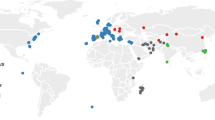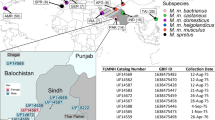Abstract
The resistance and susceptibility to the intestinal pinworm Aspiculuris tetraptera, a natural parasite of the house mouse Mus musculus, is experimentally analysed using both the F1 from wild-type mice of the two subspecies (M. m. domesticus and M. m. musculus) and the F1 from different laboratory inbred mice. The results show that: (i) the F1 from wild-type mice harbour a lower parasite load than the parental mice, suggesting a phenomenon of hybrid vigour; and (ii) the F1 from inbred mice harbour parasite loads similar to the resistant parent, suggesting that resistance is inherited as a dominant feature in these laboratory mice. This analysis supports the hypothesis that recombinations occurring between the two mouse genomes (i.e. M. m. domesticus and M. m. musculus) are responsible for the hybrid dysgenesis observed in the natural hybrid zone between the two mice subspecies.
Similar content being viewed by others
Article PDF
References
Behnke, J M. 1975. Immune expulsion of the nematode Aspiculuris tetraptera from mice given primary and challenge infections. Int J Parasitol, 5, 511–515.
Bonhomme, F, Guénet, J-L, Dod, B, Morivaki, K, and Bufield, G. 1987. The polyphyletic origin of laboratory inbred mice and their rate of evolution. Biol J Lin Soc, 30, 51–58.
Boursot, P, Bonhomme, F, Britton-Davidian, J, Catalan, J, Yonekawa, H, Orsini, P, Gerasimov, S, and Thaler, L. 1984. Introgression différentelle des génomes nucléaires et mitochondriaux chez deux semi-espèces de souris. C r Acad Sci Paris, 299, 365–370.
Coustau, C, Renaud, F, Maillard, C, Pasteur, N, and Delay, B. 1991. Differential susceptibility to a trematode parasite among genotypes of the Mytilus edulis/galloprovincialis complex. Genet Res, 57, 207–212.
Dod, B, Jermiin, L S, Boursot, P, Chapman, V H, Nielsen, J T, and Bonhomme, F. 1993. Counterselection on sex chromosomes in the Mus musculus European hybrid zone. J Evol Biol, 6, 529–546.
Dupond, F, and Crivelli, A J. 1988. Do parasites confer a disadvantage to hybrids? A case study of Alburnus alburnus × Rutilus rubilio, a natural hybrid of Lake Mikri Prespa, Nothern Greece. Oecologia, 75, 587–592.
Hewitt, G M. 1988. Hybrid zones - natural laboratories for evolutionary studies. Trends Ecol Evol, 3, 158–167.
Holm, S. 1979. A simple sequentially rejective multiple test procedure. Scand J Stat, 6, 65–70.
Hunt, W G, and Selander, R K. 1973. Biochemical genetics of hybridisation in European house mice. Heredity, 31, 11–33.
Le Brun, N, Renaud, F, Berrebi, P, and Lambert, A. 1992. Hybrid zones and host-parasite relationships: effect on the evolution of parasitic specificity. Evolution, 46, 56–61.
Moulia, C, Aussel, J P, Bonhomme, F, Nielsen, J T, and Renaud, F. 1991. Wormy mice in a hybrid zone: a genetic control of susceptibility to parasite infection. J Evol Biol, 4, 679–687.
Moulia, C, Le Brun, N, Dallas, J, Orth, A, and Renaud, F. 1993. Experimental evidence of genetic determinism in high susceptibility to intestinal pinworm infection in mice: a hybrid zone model. Parasitology, 106, 387–393.
Paige, K N, and Capman, W C. 1993. The effects of host-plant genotype, hybridization and environment on gall-aphid attack and survival in cottonwood: the importance of genetic studies and the utility of RFLPs. Evolution, 47, 36–45.
Renaud, F, Coustau, C, Le Brun, N, and Moulia, C. 1992. Parasitism in host hybrid zone. Res Rev Parasitol, 52, 13–20.
Roush, R T, and Croft, B A. 1986. Experimental population genetics and ecological studies of pesticide resistance in insects and mites. In: Committee on Strategies for the Management of Pesticide Resistant Pest Populations (eds) Pesticide Resistance: Strategies and Tactics for Management, pp. 257–270. National Academy Press, Washington, DC.
Sage, R D, Heyman, D, Lim, K C, and Wilson, A C. 1986a. Wormy mice in a hybrid zone. Nature, 324, 60–63.
Sage, R D, Whitney, J B, and Wilson, A C. 1986b. Genetic analysis of a hybrid zone between domesticus and musculus mice (Mus musculus complex): hemoglobin polymorphism. Curr Top Microbiol Immun, 127, 75–85.
Shaw, D D, Coates, D J, Arnold, M L, and Wilkinson, P. 1985. Temporal variation in the chromosomal structure of a hybrid zone and its relationship to karyotypic repatterning. Heredity, 55, 293–306.
Shaw, D D, Marchant, A D, Contreras, N, Arnold, M L, Groeters, F, and Kohlmann, B C. 1993. Genomic and environmental determinants of a narrow hybrid zone: cause or coincidence?. In: Harrison, R. G. (ed.) Hybrid Zones and the Evolutionary Process, pp. 165–195. Oxford University Press, Oxford.
Sokal, R, and Rohlf, F. 1981. Biometry, 2nd edn. W. H. Freeman, New York.
Tucker, P K, Sage, R D, Warner, J, Wilson, A C, and Eicher, E M. 1992. Abrupt cline for sex chromosomes in a hybrid zone between two subspecies of mice. Evolution, 46, 1146–1163.
Vanlerberghe, F, Dod, B, Boursot, P, Bellis, M, and Bonhomme, F. 1986. Absence of Y-chromosome introgression across the hybrid zone between Mus musculus domesticus and M. m. musculus. Genet Res, 48, 191–197.
Vanlerberghe, F, Boursot, P, Catalan, J, Gerasimov, S, Bonhomme, F, Botev, A, and Thaler, L. 1988. Analyse génétique de la zone d'hybridation entre les deux sousespèces de souris Mus musculus domesticus et M. m. musculus en Bulgarie. Genome, 30, 427–437.
Whitham, T G. 1989. Plant hybrid zones as sinks for pests. Science, 244, 1490–1493.
Wright, M D, Tiu, W U, Wood, S M, Walker, J C, Garcia, E G, and Mitchell, G F. 1988. Schistosoma mansoni and S. japonicum worm numbers in 129/J mice of two types and dominance of susceptibility in F1, hybrids. J Parasitol, 74, 618–622.
Author information
Authors and Affiliations
Rights and permissions
About this article
Cite this article
Moulia, C., Brun, N., Loubes, C. et al. Hybrid vigour against parasites in interspecific crosses between two mice species. Heredity 74, 48–52 (1995). https://doi.org/10.1038/hdy.1995.6
Received:
Issue date:
DOI: https://doi.org/10.1038/hdy.1995.6
Keywords
This article is cited by
-
Avian vampire fly (Philornis downsi) mortality differs across Darwin’s finch host species
Scientific Reports (2021)
-
Metazoan parasite communities: support for the biological invasion of Barbus barbus and its hybridization with the endemic Barbus meridionalis
Parasites & Vectors (2016)
-
Does invasive Chondrostoma nasus shift the parasite community structure of endemic Parachondrostoma toxostoma in sympatric zones?
Parasites & Vectors (2012)
-
Immunocompetence does not correlate with resistance to helminth parasites in house mouse subspecies and their hybrids
Parasitology Research (2007)



